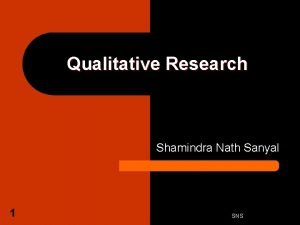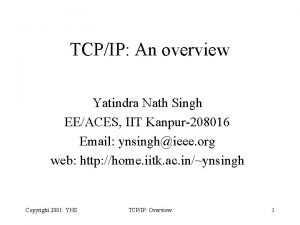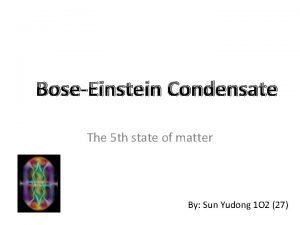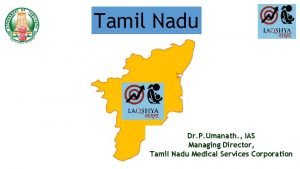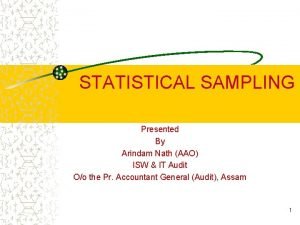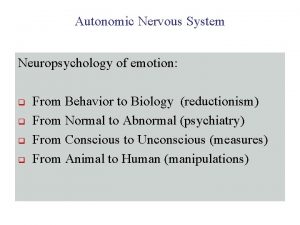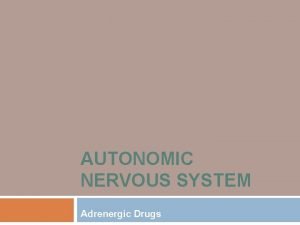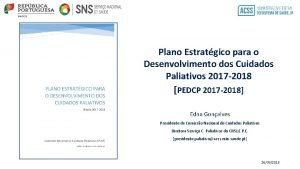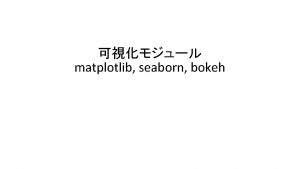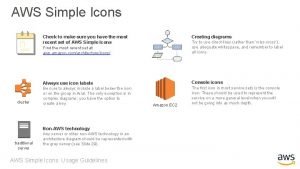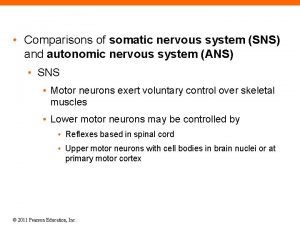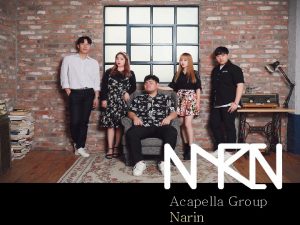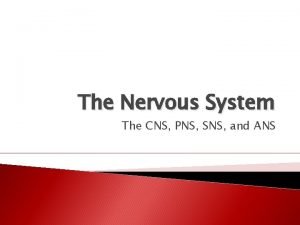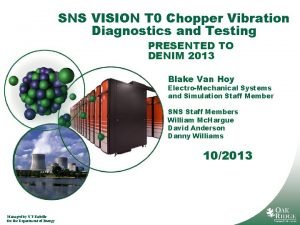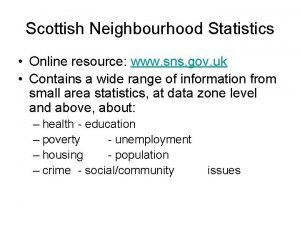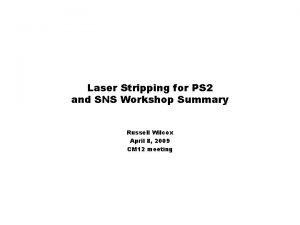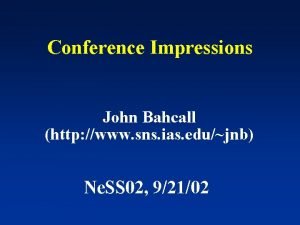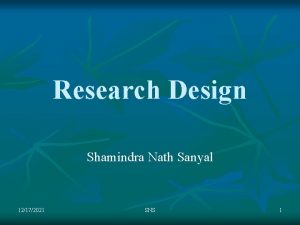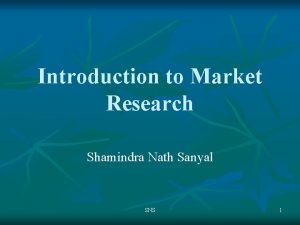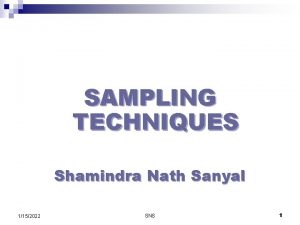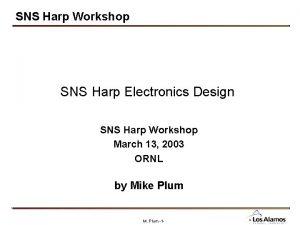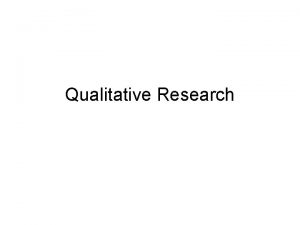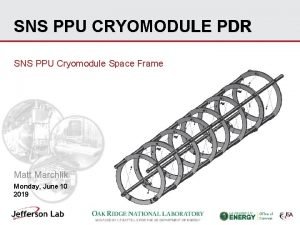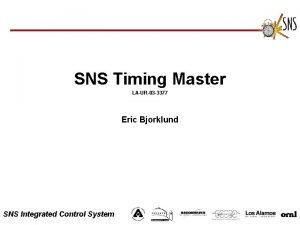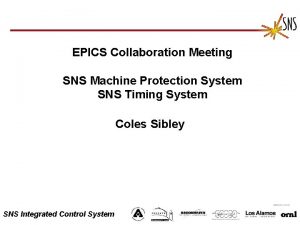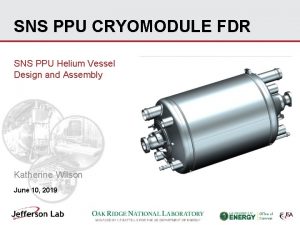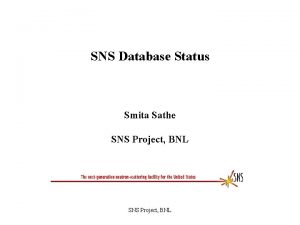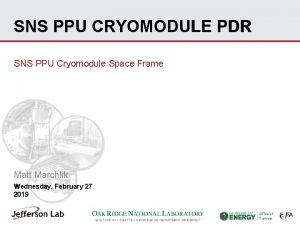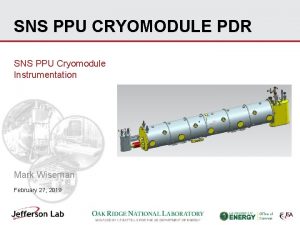Qualitative Research Shamindra Nath Sanyal 1 SNS Two





























- Slides: 29

Qualitative Research Shamindra Nath Sanyal 1 SNS

Two Research Types 2 l Quantitative research – Research that might be used to find statistical differences between data. l Qualitative research – Research whose findings are not subject to quantification or quantitative analysis. Typically used to examine feelings, attitudes and motivations behind consumers. SNS

Qualitative Research: Definition l ‘Qualitative Research…involves finding out what people think, and how they feel - or at any rate, what they say they think and how they say they feel. This kind of information is subjective. It involves feelings and impressions, rather than numbers’ (Bellenger, Bernhardt and Goldstucker, Qualitative Research in Marketing, American Marketing Association) 3 SNS

Qualitative Research: Introduction 4 l Qualitative Researchers study “things” (people and their thoughts) in their natural settings, attempting to make sense of, or interpret, phenomena in terms of the meanings people bring to them. l Qualitative research involves the studied use and collection of a variety of empirical materials - case study, personal experience, introspective, life story, interview, observational, historical, interactional, and visual texts-that describe routine and problematic moments and meanings in individuals lives. l Deploy a wide range of interconnected methods, hoping always to get a better fix on the subject matter at hand. SNS

Qualitative Research: Introduction 5 l Is any research conducted using an observational technique or unstructured questioning. l Often viewed as a “Soft-approach. ” Conducted: – when structured research is not possible, – when true response may not be available [embarrassing “touchy questions”] – to explain quantitative research results. l Should not be viewed as conclusive research. l Qualitative and quantitative research are complementary to each other. SNS

6 SNS

Qualitative Research Techniques l l 7 Individual ‘depth’ or ‘intensive’ interview Focus-group discussion Projective techniques Observation method SNS

Individual ‘depth’ or ‘intensive’ interview 8 l Typically requires 30 -45 minutes. l The interviewer does not have a specific set of pre-specified questionnaire. l The respondent is given a chance to freely express his ideas and thoughts. SNS

Individual ‘Depth’ or ‘Intensive’ Interview l Durgee recommended three questioning techniques for use in individual depth interview. l Laddering l Hidden-issue questioning l Symbolic questioning 9 SNS

Laddering Technique Laddering involves to allow respondents identify characteristics that distinguish brands. e. g. “In what way Pepsi is different from Coca Cola? ” And the process goes on 10 Each distinguishing attribute is then analyzed to determine why it is important to the customers. These reasons are then analyzed to determine why they are important SNS

Purpose of Laddering l 11 To uncover the “network of meanings” associated with the product or service. SNS

Hidden-issue Questioning 12 l It focuses on individual respondent’s feelings about sensitive issues, e. g. having a desire for affair. l Analysis focuses on common themes across respondents. l These themes can then be used to guide advertising development. SNS

Symbolic Questioning 13 l Respondents are to describe the opposites of product/service of interest. l It may be a specific attribute of the product/service. SNS

Individual Depth Interview Areas l l l 14 When detailed probing of attitude, behavior is required For a very confidential subject matter Emotional or embarrassing subject matter When certain strong, socially acceptable norm exists When detailed understanding of complicated decision pattern is necessary Interviews with professional people SNS

Limitations of In-depth Interview l l 15 Skill of the interviewer is very critical Respondents’ verbal and non-verbal communications are to be followed very carefully Sample size must be small Generalization of the entire population cannot be done SNS

Focus Group Interview l An interview conducted by a trained moderator in a nonstructured and natural manner with a small group of respondents. Group Size Group composition 8 -12 homogeneous in terms of demographic and socio-economic characteristics, Physical setting relaxed and informal Duration 1 -3 hrs. Moderator Observational, interpersonal, good communicator 16 SNS

Objectives ● Generate new product or service ideas ● Understand consumer vocabulary ● Useful for ad campaigns ● Reveal consumer needs, motives, perceptions and attitudes ● Generating future research objectives ● Facilitate understanding of the quantitative studies 17 SNS

Applications 18 l Basic-needs studies for product idea creation l New product idea creation l Product positioning strategies l Marketing communications research SNS

Steps l l l l 19 Specify objectives categorically State questions to be answered Screen questions based on familiarity and knowledge of the subject matter, usage behavior, attitude and participation in focus groups and demographic characteristics Develop the moderator’s outline – moderator must understand the clients business, focus group objectives and how the findings will be used in future. Conduct the focus group interview. Review recordings and analyze data Summarize findings and plan follow-up research or action SNS

Advantages of Focus Group Interview 20 l Synergism: When a group of people with similar interest discuss an issue together they are expected to produce a rich insight, a wide range of information and innovative ideas than will individual respondents obtain separately. l Snowballing: In a group discussion one person’s comment sets a chain reaction from other participants and generates more views. l Stimulation: Once the focus group discussion in on, general level of interest over the topic increases, and a large no. of respondents want to share their views and express their feelings. SNS

Advantages of Focus Group Interview 21 l Security: Because of the homogeneity of composition, focus group participants are expected to have similar feelings. This enables them to feel comfortable to express their feelings. l Spontaneity: Focus group participants are not required to answer specific questions. Their responses can be spontaneous and unconventional that reflect an accurate idea of their views. l Speed: Because people discuss the issues spontaneously, the speed of the total process becomes very high. l Inexpensive: Considering the richness of the output, the total process is relatively inexpensive for data collection. SNS

Disadvantages of Focus Group Interview l l l 22 Lack of representativeness: Since focus groups are not the representatives of the general population, the result can not be generalized and projected as the only basis for decision making. Misjudgment: Compared to the other methods of data collection, this method is susceptible to client and researcher biases and thereby, misjudgment. Misused: Focus groups can be misused considering the results as conclusive rather than exploratory. Moderation: Moderation quality is an important factor for successful focus group interview results. Difficult to Analyze: The unstructured nature of the responses of the focus group makes the analysis and interpretation difficult SNS

Projective Techniques 23 l These are indirect interviewing methods which enable respondents to project their ideas, beliefs and feelings to a third -party or into some task situation. l The researcher sets up a situation for the respondents asking them to express their own views, or to complete/ interpret some ambiguous situations presented to them. l Generally used by the researcher when language barrier, illiteracy among respondents, social barrier or psychological barrier create difficulty. SNS

Projective Techniques: Types l Various types. More common ones are: l l l 24 Free word association test Sentence completion test Unfinished scenario/story completion Cartoon completion test Picture interpretation (Thematic Appreciation Test) SNS

Observation l Appropriate Conditions – The event must occur in a short time interval l – avoid lag affect Must occur in a setting where the researcher can observe the behavior ● praying, cooking are not suitable things to observe - Necessary under situations of faulty recall l 25 faulty recall>>remembering things such as how many times one looked at his wristwatch SNS

Advantages of Observation ● Greater data accuracy than direct questioning, in natural settings people behave naturally, ● Problems of refusal, not at home, false response, non-cooperation etc. are absent, absent ● Does not rely on willingness of respondents to cooperate and supply information ● No recall error, error ● In some situations, only way l l 26 Number of customers visiting a store Studying children’s behavior SNS

Disadvantages of Observation 27 l Time consuming. l Too many things to observe. l May not be representative of the population. l Difficulty in determining root cause of the behavior, i. e. consumers’ beliefs, feelings, awareness etc. SNS

Classification of Observation 28 l Natural vs. Contrived observation l Disguised vs. Undisguised observation l Structured vs. Unstructured observation l Human vs. Mechanical observation SNS

29 SNS
 Shamindra nath sanyal
Shamindra nath sanyal Yatindra nath singh
Yatindra nath singh Bose einstein condensate
Bose einstein condensate Kg technologies india pvt ltd
Kg technologies india pvt ltd Dr reshmi nath
Dr reshmi nath Dr. p. umanath i.a.s. profile
Dr. p. umanath i.a.s. profile Arindam nath
Arindam nath Dilated pupils death
Dilated pupils death Sample of ethical consideration in research
Sample of ethical consideration in research Research chapter 3
Research chapter 3 Qualitative vs quantitative
Qualitative vs quantitative Nature of qualitative research
Nature of qualitative research Somatic nervous system (sns)
Somatic nervous system (sns) Psns and sns
Psns and sns Psns and sns
Psns and sns Ans
Ans Sns. gov. pt
Sns. gov. pt Bokeh seaborn
Bokeh seaborn Aws codecommit icon
Aws codecommit icon Sns
Sns Sns
Sns Narin acapella
Narin acapella Cns and sns
Cns and sns Limbic system and trauma
Limbic system and trauma Magnetic bearing
Magnetic bearing Sns.gov
Sns.gov Sns workshop
Sns workshop Ias sns
Ias sns Findings of qualitative research
Findings of qualitative research Holistic data collection
Holistic data collection
